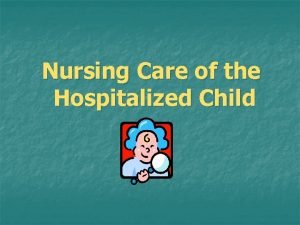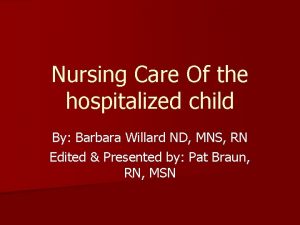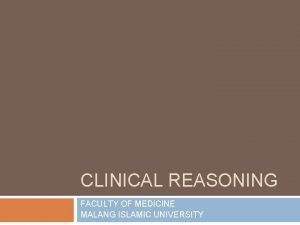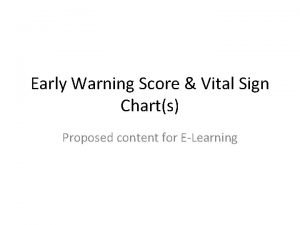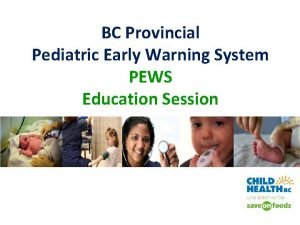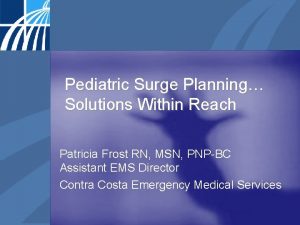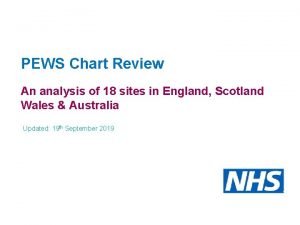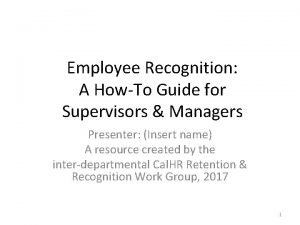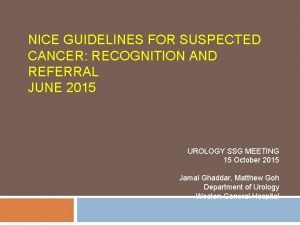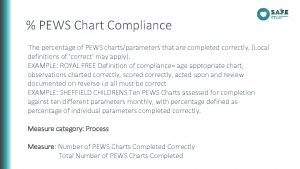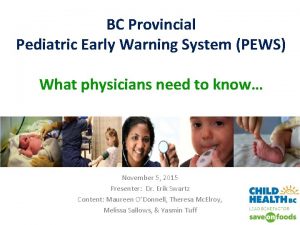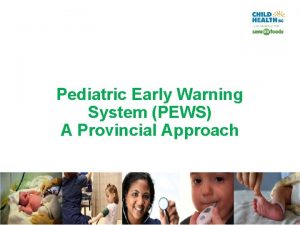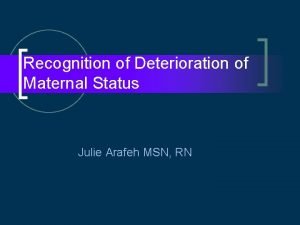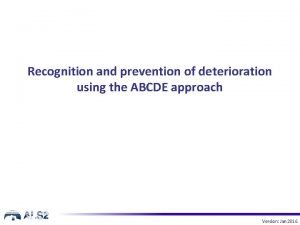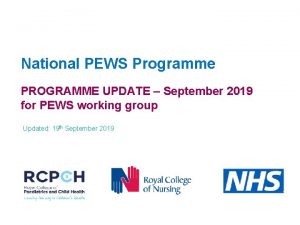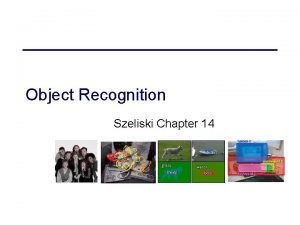PEWS Early Recognition of Clinical Deterioration in Hospitalized


































- Slides: 34

PEWS: Early Recognition of Clinical Deterioration in Hospitalized Children with Cancer Asya Agulnik, MD, MPH Assistant Member Director, Global Critical Care Program Division of Critical Care Department of Global Pediatric Medicine St. Jude Children’s Research Hospital

Questions? globalcriticalcare@stjude. org Asya. Agulnik@stjude. org

Clinical Deterioration in Hospitalized Children • Cardiopulmonary arrests are rare events in children: – 1. 4% of PICU admissions – 0. 08% of hospital admissions • However, poor survival to hospital discharge – 27 -48% • Pediatric hematology-oncology/HSCT patients – Higher frequency of clinical deterioration • 1 in every 3 -4 patients will require critical care during cancer treatment – Higher mortality following critical illness and cardiopulmonary arrests Berg 2016, Knudson 2012, Del Castillo 2014, Girotra 2013, Nadkarni 20106

Consequences of Delayed Identification • Delayed ICU transfer in patients with cancer results poor outcomes – Increased organ dysfunction, longer ICU length of stay, higher hospital mortality – Every hour delay in ICU transfer after deterioration results in 3% increased odds of mortality • Reasons for delays: – Failure to recognize physiologic changes, delays in notification of treating physician, lack of prompt bedside evaluation Cardoso 2011, Young 2003, Sankey 2016, Churpek 2016

Prevention • Physiologic changes (VS, mental status) occur hours before acute event – Frequently missed or not acted upon by medical team – Delayed ICU transfer/notification lead to poor outcomes • Systems to facilitate early identification and early action can improve outcomes Tume 2007

What are PEWS? Pediatric Early Warning Systems • Systems to improve early identification of clinical deterioration in hospitalized patients • Two components: – Scoring Tool: vital signs, physical exam, interventions (O 2 use) • Calculated with every set of vital signs – Algorithm: guide clinical team in actions needed to respond to patient with deterioration

Vital Signs PEWS Physician Evaluation PICU Care • Nurses calculate PEWS with every set of vital signs as part of routine patient care • Physicians responsible for evaluating patients with abnormal scores and determining the next steps in management according to action algorithm • PEWS is an advocacy tool – Empowers nurses to identify clinical changes and express concerns to the medical team

PEWS – Results • Hospital-wide PEWS implementation (score + action algorithm) leads to: – Shorter time between deterioration and medical interventions – Lower severity of illness on ICU admission – Shorter ICU LOS for unplanned transfers – Fewer cardiopulmonary arrests outside the ICU – Lower hospital mortality Are PEWS valid in hospitalized pediatric oncology and HSCT patients? Bonafide 2013, Brilli 2007, Olson 2013, Sefton 2014, Chapman 2016

PEWS Validation Pediatric Oncology – Unplanned PICU transfers among hospitalized pediatric Oncology and HSCT patients over 2 years • 110 events • 15. 5% PICU mortality

Agulnik PCCM 2016

Agulnik PCCM 2016

Results—Validation • PEWS valid to identify patients requiring unplanned PICU transfer – AUROC Onc— 0. 95 – AUROC HSCT— 0. 96 • PEWS elevate ~12 hours prior to PICU transfer – 8 hours earlier then standard ICU notification by floor team Agulnik PCCM 2016

PEWS and PICU Outcomes PICU LOS Maximum PEWS before PICU transfer 3 or less PICU Mortality # Cases PICU LOS (days) 15 3 4 19 3 5 21 3 6 19 4 7 or more 19 Agulnik PCCM 2016 14 p=0. 004 p=0. 028

St. Jude Advanced Warning System s. JAWS Adapted from Boston’s PEWS tool by multidisciplinary team at St. Jude Modification of PEWS Hospital-wide Pilot in Leukemia Implementation Jan Feb Mar Apr May Jun Jul Aug Sep Oct Nov Dec 2016

St. Jude Emergency Activations/ 1000 Inpatient Days Inpatient RRTs s. JAWS RRTs Apr-17 Mar-17 Feb-17 Jan-17 Dec-16 Nov-16 Oct-16 Sep-16 Aug-16 Jul-16 Jun-16 May-16 Apr-16 Mar-16 Feb-16 Jan-16 Dec-15 Nov-15 Oct-15 Sep-15 Inpatient HT Aug-15 20 18 16 14 12 10 8 6 4 2 0 s. JAWS Pilot Hospital Implementation Agulnik SCCM 2018

St. Jude Unplanned PICU Transfers PICU transfer with s. JAWS 3+ PICU Transfer via RRT Apr-17 Mar-17 Feb-17 Jan-17 Dec-16 Nov-16 Oct-16 Sep-16 Aug-16 Jul-16 Jun-16 May-16 Apr-16 Mar-16 Feb-16 Jan-16 Dec-15 Nov-15 Oct-15 Sep-15 PICU Transfer via HT Aug-15 100% 90% 80% 70% 60% 50% 40% 30% 20% 10% 0% s. JAWS Pilot Hospital Implementation Agulnik SCCM 2018

Unidad Nacional de Oncología Pediátrica (UNOP) • Guatemala City, Guatemala • 67 -bed hospital – >2000 admissions/year • 9 -bed PICU – 300 -400 admissions/year • >50% childhood cancer cases in Guatemala (500 new dx/year) Escala de Valoración de Alerta Temprana (EVAT) • Based on PEWS validated in pediatric oncology • Changes made by multidisciplinary team: – Translate into Spanish and adjust for practice variation Agulnik Cancer 2017


PEWS Errors at UNOP 50% 45% 40% 35% 30% 25% 20% 15% 10% 5% 0% % PEWS Errors n=300 -400/day 11 /1 / 12 14 /1 /1 4 1/ 1/ 15 2/ 1/ 1 3/ 5 1/ 15 4/ 1/ 15 5/ 1/ 15 6/ 1/ 1 7/ 5 1/ 15 8/ 1/ 15 9/ 1/ 10 15 /1 /1 11 5 /1 / 12 15 /1 /1 5 % Errors in PEWS Nov 2014 – Dec 2015 Date of Measurement Agulnik Cancer 2017

Outcome of PEWS at UNOP 10 9 8 7 6 5 4 3 2 1 0 1600 9. 3 1400 6. 5 1376 1200 1088 1000 800 600 400 2013 Agulnik Cancer 2017 PICU Patient-Days (Unplanned Transfers) PICU Patient-Days Clinical Deterioraiton Events / 1000 pt-days Clinical Deterioration Events Year 2015 p=0. 003 0 2013 Year 2015 p<0. 0001

PEWS Validation (UNOP) • PEWS is valid to predict unplanned PICU transfer in these patients in this setting – Abnormal PEWS as early as 24 hours prior to unplanned PICU transfer • Higher PEWS at PICU admission predicts organ dysfunction, severity of illness (PIM 2), need for PICU interventions (mechanical ventilation, vasoactive infusions) and mortality Agulnik Cancer 2017

Costing Analysis of PEWS • UNOP had 457 fewer ICU days for unplanned PICU transfers in the year following PEWS implementation • Cost of PEWS implementation at UNOP in 2014 was ~$14, 000 – $7 per hospital admission that year • Implementation of PEWS resulted in a cost-savings of over $350, 000 in 2015 Conclusion: Implementation of PEWS can improve quality of care and reduce hospital costs though reducing unplanned PICU transfer Agulnik Cancer 2019

Ongoing Questions • Is UNOP’s experience with PEWS generalizable to other pediatric oncology centers in Latin America? – Different hospital organization – Different nursing ratios – Different access to PICU PEWS Multicenter Program (Proyecto EVAT)

Proyecto EVAT Goals • Compare frequency, characteristics, and outcomes of clinical deterioration events in hospitalized pediatric oncology and HSCT patients across Latin America • Evaluate effect of PEWS implementation on frequency and severity of clinical deterioration events • Identify center, team, and implementation factors associated with successful PEWS implementation

Proyecto EVAT CALI QUITO 45 Centers, 17 Countries TIJUANA CHIHUAHUA CUENC A HAITI SANTIAGO LA PAZ CHILE QUERETARO BUENOS AIRES MERIDA PACHUCA GUADALAJARA CDMX XALAPA TOLUCA CORDOBA CAMPECHE PUEBLA CHIAPAS GUATEMALA TEGUCIGALPA SALVADOR With EVAT (4) MANAGUA EVAT 2017 (13) EVAT 2018 (10) EVAT 2019 (18) SALVADOR COCHABAMBA BAHIA LA PAZ PARAGUAY SAN LUIS POTOSI CELAYA SANTA CRUZ LIMA SANTO DOMINGO MONTERREY CULIACAN GUAYAQUIL SAN JOSE PANAMÁ CHIRIQUI

Steering Committee Proyecto EVAT • 24 members from Latin America • 7 countries • México • El Salvador • Ecuador • Guatemala • Perú • Honduras • Chile • 11 nurses • 2 pediatricians • 6 oncologists • 5 intensivists St. Jude, Memphis 5 th EVAT SC Meeting, August 13 -14, 2019

Proyecto EVAT Phases Clinical Deterioration: – Unplanned PICU transfers – PICU interventions (vasopressors, mechanical ventilation, CPR) on the floor – Non-palliative floor deaths

Results Pediatric oncology patients hospitalized in 16 centers between June 2017 and May 2018 (12 months) 11, 797 hospital admissions 116, 191 4. 6% 546 clinical deterioration events 4. 7/1000 patient-days patient days 159 (29%) Agulnik SIOP 2018 hospital admissions died during event 192 (35%) died prior to hospital discharge

Center Variability CDE rate % hospital admissions Agulnik SIOP 2018 CDE rate / 1000 patient days CDE mortality % CDE events Hospital Mortality % CDE events

Clinical deterioration events • 546 clinical deterioration events – Floor interventions: 155 (28%) required PICU-level interventions on the floor • Higher risk of mortality (p=0. 004) – PICU transfer: 494 (90%) ultimately transferred to PICU • 10% never had access to PICU care – Delays: 228 (42%) noted delays in identification of deterioration or PICU transfer Agulnik SIOP 2018

Lessons Learned • One goal: successful implementation of PEWS at each center – Lead to improved patient outcomes – Achieving program sustainability • Centers need different timelines, resources, support to achieve this goal – But every center can achieve it with appropriate support • Currently: 21 centers with successful PEWS implementation • More than 2000 clinicians trained in EVAT across 17 countries • Over 1500 clinical deterioration events registered • There are center and team-specific factors associated with programmatic success

Factors Associated with Implementation Success • Strong multidisciplinary leadership team – Oncology, pediatrics, nursing, PICU – All team leaders dedicated to the project and participate in the all program activities – Helps to have prior experience with quality improvement (but not required) • Support of hospital leadership (from the beginning) • Active communication with St. Jude and Mentor Center of Excellence – Attend on-line meetings, answer emails, actively ask questions • Think of programmatic sustainability from the beginning – Prepared for a long-term program plan (3 years!)

1 st Annual Meeting March 22 -23, 2019 HITO Queretaro, Mexico Thank You! Proyecto. EVAT@stjude. org

Questions? globalcriticalcare@stjude. org Asya. Agulnik@stjude. org registration: www. stjude. org/POCCS
 Nursing care of hospitalized child
Nursing care of hospitalized child Nursing care of hospitalized child
Nursing care of hospitalized child Cpdst
Cpdst Global deterioration scale pdf
Global deterioration scale pdf Osmophillic
Osmophillic Wear vs deterioration in software engineering
Wear vs deterioration in software engineering Pattern recognition clinical reasoning
Pattern recognition clinical reasoning Cewt chart 5-11
Cewt chart 5-11 Bentactur
Bentactur Patrisia surge
Patrisia surge Pews chart 1-4
Pews chart 1-4 Pews score kind
Pews score kind Early cpr and early defibrillation can: *
Early cpr and early defibrillation can: * Awards recognition concepts
Awards recognition concepts Mkr cro
Mkr cro Kinect for windows speech recognition language pack
Kinect for windows speech recognition language pack Pattern recognition slides
Pattern recognition slides Fors fleet operator recognition scheme
Fors fleet operator recognition scheme Recall vs recognition
Recall vs recognition Closing prayer
Closing prayer Cm bishop pattern recognition and machine learning
Cm bishop pattern recognition and machine learning Speech recognition
Speech recognition Pqa levels of recognition
Pqa levels of recognition Objectives of pattern recognition
Objectives of pattern recognition Identification type of test instruction
Identification type of test instruction Chapter 18 revenue recognition
Chapter 18 revenue recognition Introduction about social media
Introduction about social media Employee recognition toolkit
Employee recognition toolkit Suspected cancer recognition and referral
Suspected cancer recognition and referral Revenue recognition income statement
Revenue recognition income statement California association of school psychologists
California association of school psychologists Chapter 18 revenue recognition kieso
Chapter 18 revenue recognition kieso Dragon speech recognition
Dragon speech recognition Reinforcing effort and providing recognition
Reinforcing effort and providing recognition Matlab fingerprint recognition
Matlab fingerprint recognition
